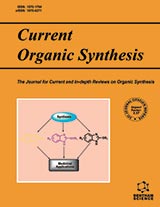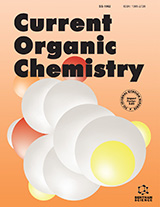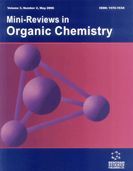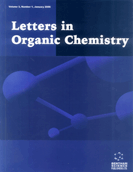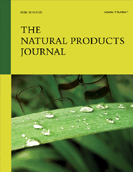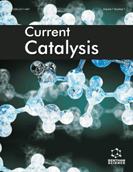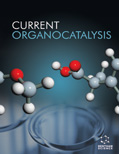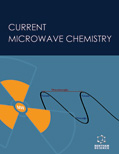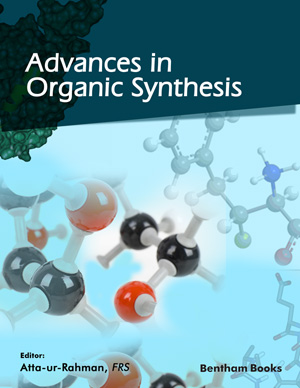Abstract
Aim and Objective: The use of glycosyloxymethylfurfural (GMF), the dehydration product of isomaltulose, in the one-step multicomponent aza-Morita-Baylis-Hillman (aza-MBH) reaction, was studied.
Materials and Methods: The reaction conditions and scope were investigated with respect to solvent, combinations of catalysts (Lewis acids and nucleophilic base), and the nature of the amine and the acrylic partners.
Results: The three-components one step aza-MBH reaction using GMF, sulfonamides and a Michael acceptor provides carbohydrate-based a-methylene-b-amino carbonyl derivatives in moderate to good yields. Optimized conditions are the use of La(OTf)3 and 3-HQD in methanol. The use of diphenylphosphinamide, though requiring the use of a protected GMF and a two-step protocol, offers alternatives in the type of activated imine involved the classical sulfonyl substitution.
Conclusion: A wide structural range of adducts were obtained in fair to good yields, showing the synthetic efficiency of the strategy able to provide highly functionalized carbohydrate-containing new molecules in an unique step from very available starting materials. These explorations show that GMF can be transformed in very short sequences to rather elaborated new compounds using the MBH and aza-MBH strategy.
Keywords: Isomaltulose, glycosyloxymethylfurfural (GMF), hydroxymethylfurfural (HMF), aza-Morita-Baylis-Hillman, multicomponent, carbohydrate.
Graphical Abstract
Current Organic Synthesis
Title:Glycosyloxymethylfurfural (GMF) in Multicomponent Aza-Morita-Baylis-Hillman Reaction: Rapid Access to Highly Functionalized Carbohydrate Scaffolds
Volume: 15 Issue: 3
Author(s): Jia-Neng Tan, Mohammed Ahmar and Yves Queneau*
Affiliation:
- Univ Lyon, INSA-Lyon, Universite Lyon 1, CNRS, CPE Lyon, Institut de Chimie et Biochimie Moleculaires et Supramoleculaires, ICBMS, UMR5246, INSA Lyon, Villeurbanne F-69621,France
Keywords: Isomaltulose, glycosyloxymethylfurfural (GMF), hydroxymethylfurfural (HMF), aza-Morita-Baylis-Hillman, multicomponent, carbohydrate.
Abstract: Aim and Objective: The use of glycosyloxymethylfurfural (GMF), the dehydration product of isomaltulose, in the one-step multicomponent aza-Morita-Baylis-Hillman (aza-MBH) reaction, was studied.
Materials and Methods: The reaction conditions and scope were investigated with respect to solvent, combinations of catalysts (Lewis acids and nucleophilic base), and the nature of the amine and the acrylic partners.
Results: The three-components one step aza-MBH reaction using GMF, sulfonamides and a Michael acceptor provides carbohydrate-based a-methylene-b-amino carbonyl derivatives in moderate to good yields. Optimized conditions are the use of La(OTf)3 and 3-HQD in methanol. The use of diphenylphosphinamide, though requiring the use of a protected GMF and a two-step protocol, offers alternatives in the type of activated imine involved the classical sulfonyl substitution.
Conclusion: A wide structural range of adducts were obtained in fair to good yields, showing the synthetic efficiency of the strategy able to provide highly functionalized carbohydrate-containing new molecules in an unique step from very available starting materials. These explorations show that GMF can be transformed in very short sequences to rather elaborated new compounds using the MBH and aza-MBH strategy.
Export Options
About this article
Cite this article as:
Tan Jia-Neng , Ahmar Mohammed and Queneau Yves *, Glycosyloxymethylfurfural (GMF) in Multicomponent Aza-Morita-Baylis-Hillman Reaction: Rapid Access to Highly Functionalized Carbohydrate Scaffolds, Current Organic Synthesis 2018; 15 (3) . https://dx.doi.org/10.2174/1570179415666180103155212
| DOI https://dx.doi.org/10.2174/1570179415666180103155212 |
Print ISSN 1570-1794 |
| Publisher Name Bentham Science Publisher |
Online ISSN 1875-6271 |
 14
14 2
2 2
2
- Author Guidelines
- Bentham Author Support Services (BASS)
- Graphical Abstracts
- Fabricating and Stating False Information
- Research Misconduct
- Post Publication Discussions and Corrections
- Publishing Ethics and Rectitude
- Increase Visibility of Your Article
- Archiving Policies
- Peer Review Workflow
- Order Your Article Before Print
- Promote Your Article
- Manuscript Transfer Facility
- Editorial Policies
- Allegations from Whistleblowers


